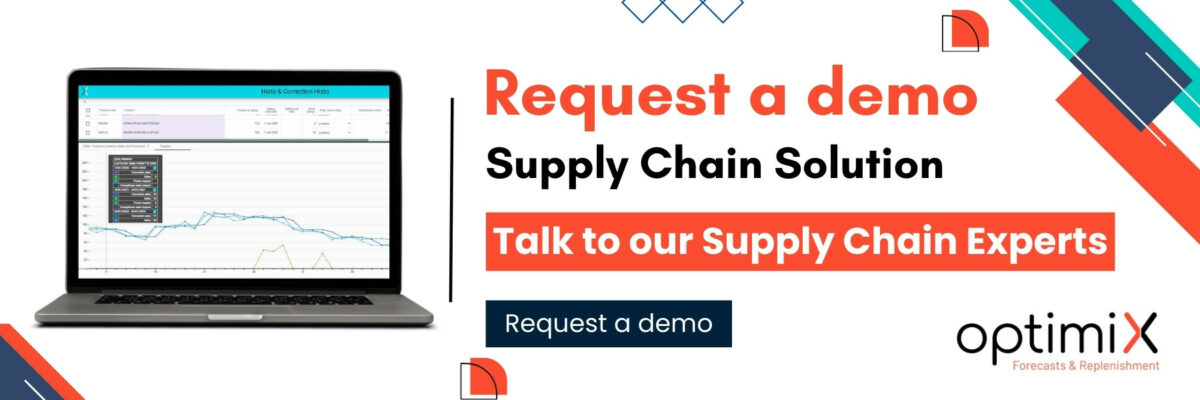In the current context marked by growing consumer awareness regarding healthy eating, the organic products sector has experienced remarkable expansion. Indeed, interest in organic products has greatly intensified in recent years, with sales exceeding 125 billion euros by 2021symbolizing significant annual growth.
In France, the growth of the organic market is equally impressive, with sales volumes doubling in just 5 years to reach 13.2 billion euros by 2020. This growth is inevitably accompanied by specific challenges, particularly in terms of logistics and supply chain. Indeed, the unique characteristics of organic products, such as their limited availability and their reduced lifespan require adapted supply and distribution strategies.
This article therefore aims to explore the various challenges and opportunities associated withsupply chain optimization in the organic market, highlighting the strategies and innovations needed to successfully navigate this sector.
Challenges and opportunities of the Organic Supply Chain
1. Durability
AI can help improve sustainability in the cosmetic supply chain by optimizing operations and reducing waste. For example, AI-powered predictive analytics can help forecast demand accurately, helping to reduce excess production and minimize waste.
Additionally, AI can help identify inefficiencies in the supply chain, such as energy consumption and transportation, and suggest ways to reduce carbon emissions.
By using AI, cosmetic companies can not only reduce their environmental impact, but also improve their brand reputation and meet consumer demands for sustainable products.
2. Digitalisation
AI can help accelerate digitalization in the cosmetics supply chain by automating processes, improving data accuracy and providing real-time insights.
For example, AI-powered chatbots can help manage customer inquiries, freeing up time for customer service representatives to focus on more complex tasks.
Additionally, AI-powered predictive maintenance can help prevent equipment failures, helping to reduce downtime and maintenance costs. By using AI, cosmetic companies can improve efficiency, reduce costs and provide a better customer experience.
3. Personnalisation
AI can help enable personalization in the cosmetic supply chain by analyzing consumer data and providing personalized recommendations.
For example, AI-powered algorithms can analyze consumer behavior, preferences, and skin type to recommend personalized cosmetic products. Additionally, AI can help cosmetic companies create personalized products, such as foundation shades, based on individual consumer data.
By using AI, cosmetic companies can meet the growing demand for personalized products and improve customer satisfaction.
4. Regulatory compliance
AI can help ensure regulatory compliance in the cosmetic supply chain by automating quality control, improving record keeping, and providing real-time alerts.
For example, AI-powered computer vision can help inspect products for defects, helping ensure quality standards are met.
Additionally, AI-powered blockchain can help track and trace products throughout the supply chain, helping to ensure regulatory requirements are met. By using AI, cosmetic companies can improve compliance, reduce risks and avoid costly fines.
5. Skills shortage
AI can help solve the skills shortage in the cosmetic supply chain by automating routine tasks, providing training and identifying talent.
For example, AI-powered chatbots can provide on-the-job training, reducing the need for in-person training. Additionally, AI-powered talent management systems can help identify and retain talent, leading to reduced turnover and improved productivity.
By using AI, cosmetic companies can build a skilled workforce, improve employee satisfaction and reduce costs.
Dangers of shortage vs. overstocking problems
The use of specialized software tools for supply chain planning has become essential. These tools enable precise demand forecasting and effectively integrate multi-supplier supply management.
They take into account commitments and contracts with suppliers when calculating needs. These forecasts are generally established over a medium or long term, thus allowing producers to organize themselves to meet estimated capacities. This approach requires a high degree of flexibility in process modeling and calculations.
Indeed, given the duration of commitments and the constant evolution of market conditions, regular adjustments are necessary to stay in line with the reality on the ground, fluctuations in demand and competition.

Reduced life cycle
The sustainability of organic products is characterized by a relatively limited shelf life, resulting from their increased maturity and the restricted use of preservative substances. This characteristic requires meticulous management of supply and inventory to maintain the balance between avoiding stock-outs in stores and reducing excess unsold items. Organic products are subject to rigorous quality controls, requiring specific inventory management. The importance of a logistics platform flexible and intelligent is felt in this context. Such a platform, by generating alerts and suggested orders based on expiration dates, diversity of suppliers, frequency of deliveries and the complexity of varied inventories, becomes crucial. It optimizes supply and inventory management based on real-time monitoring, thus making it possible to minimize product losses.
Food mileage
At the same time, the concept of food mileage underlines the importance of the distance food travels from its point of production to the end consumer.
This parameter is essential, as it directly influences the environmental, social and economic implications of food production, distribution and sales methods.
In a context where sustainability is taking center stage, many major players in the food sector are becoming aware of the importance of reducing food miles.
By reducing this distance, they are committed not only to mitigating the environmental impact of their activities, particularly in terms of greenhouse gas emissions, but also to promoting social responsibility in favor of a more sustainable environment and responsible.

Transparency
Trust in the brands that supply, process and distribute organic products is now fundamental. However, the sector has been shaken by deception scandals where conventional products were sold as organic, undermining consumer confidence and tarnishing the industry’s image.
This unfair practice underlines the crucial importance of of honesty and transparency on the part of those involved in the organic supply chain.. It is imperative that the latter, in close collaboration with their partners, adopt rigorous measures to guarantee the clarity and veracity of information on the origin and nature of products throughout the process, from the field to the consumer.
This approach is not only an ethical imperative but also a major strategic asset for gaining and preserving consumer trust in an increasingly conscious and demanding market.
Technological innovation in the food industry
Thanks to the advancement of artificial intelligence, machine learning and predictive analytics techniques, the food industry is transforming. It is now possible to streamline processes, optimize delivery times, actively manage inventories and significantly reduce food waste throughout the production cycle.
The introduction of robots and cobots (collaborative robots) marks a new era in manufacturing, including food production. This development not only increases efficiency and productivity; it also plays a crucial role in improving the working conditions of employees, reducing expenses and improving the overall performance of the industry.

Accelerated expansion
The rapid pace of change in the organic produce sector means that new stores are opening all the time. a constant strain on the logistics network and a significant increase in the volume of products to manageinformation to be analyzed and tasks to be carried out.
The information processed is extremely varied, continuously growing and includes elements such as sales histories, market dynamics and directions, product periodicity, weather conditions, regional disparities, as well as different business initiatives such as events. and promotional offers.
Without appropriate intervention, there is a risk of compromising the quality of the services offered. This could manifest itself in an increase in stock shortages, an increase in logistics costs and an increase in the rate of product losses. As a result, economic efficiency could be reduced, along with market share.
It is therefore imperative to put in place strategic solutions to effectively manage this growth and avoid negative consequences on the distribution chain and the overall economic performance of the sector.
Management and anticipation of logistics flows
Faced with emerging challenges and opportunities, industry stakeholders such as distributors, designers and manufacturers must adopt advanced technology solutions that promote the automation of operational processes while optimizing the overall efficiency of the supply chain.
The advent of advanced software, integrating technologies such as data analysis, algorithmic optimization and artificial intelligence, makes it possible to effectively manage the continuous increase in data volumes. These tools facilitate the rapid execution of critical tasks such as demand forecasting, supply management and optimization of stock levels to meet consumer demand in an agile way.
Their flexible design allows the supply chain structure to be adapted to changing needs without questioning pre-existing processes or data models, or starting from the beginning each time.
Take the example of the supply chain solution – Optimix XFR. Thanks to its in-depth analysis of sales histories and its inventory optimization mechanism, XFR effectively predicts future needs, thus facilitating optimal resource management. The resulting procurement recommendations allow to minimize stocks while ensuring better product availability.
Conclusion
The cosmetics supply chain faces significant challenges, but AI can help solve these challenges and create opportunities for the industry. By using AI, cosmetic companies can improve sustainability, digitalization, personalization, regulatory compliance and skills.
The future of the cosmetics supply chain is bright, but it requires bold leadership, strategic planning and a commitment to innovation and continuous improvement. With AI, the cosmetics supply chain can become more effective, efficient and sustainable, meeting the demands of consumers and regulators while improving profitability and brand reputation.
Adopting these next-generation technologies frees up logistics professionals, from forecasters to supply chain managers, to focus on complex, high-value tasks. By automating standard processes, these tools promise a significant transformation of logistics management, leading to increased efficiency and improved responsiveness to market demands.
Try our Supply Chain XFR solution dedicated to calculating sales forecasts and managing supply, to see how it can transform your supply chain into an agile and responsive force.
Contact us !








